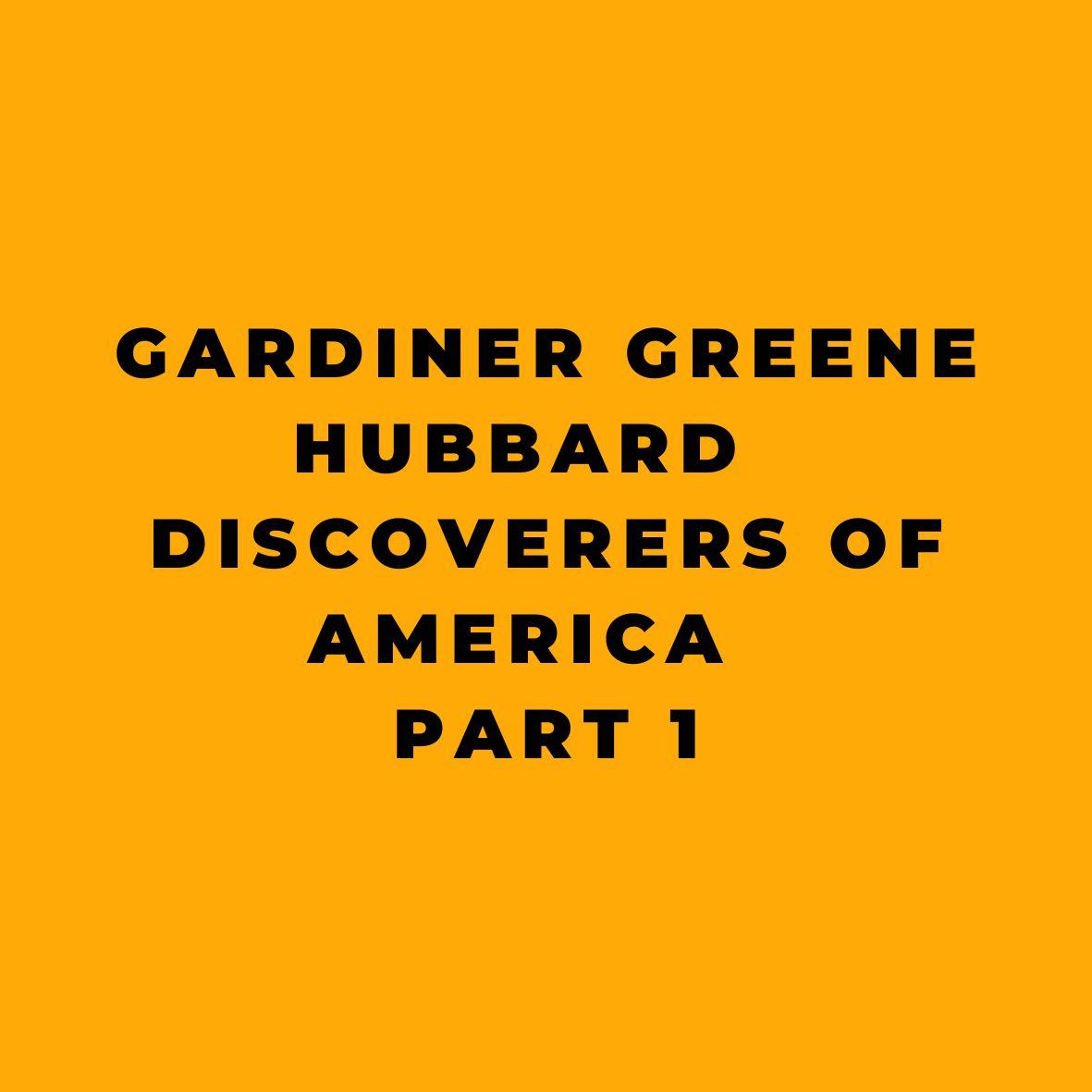DISCOVERERS OF AMERICA – ANNUAL ADDRESS BY THE PRESIDENT – HON GARDINER GREENE HUBBARD
(Presented before the Society January 13, 1893)
This is Part 1 of 4.
Part 1, Part 2, Part 3, Part 4
It is appropriate that we should take as the theme of our annual address for the year 1892 the discoverers of America. The discovery of America was the work, not of one explorer but of many, carried on during a long series of years , beginning with the Northmen, continued by Columbus, Vespucius, Magellan and Drake, and ending only with the nineteenth century. Before we speak of the discoverers let us hastily review the condition of the old world prior to the discovery of the new. Two thousand years ago philosophers generally believed the world to be round, and the most noted of ancient geographers, Eratosthenes, computed its circumference at 25,200 geographic miles. The true figure is 21,600 geographic miles or 24,899 English miles.
Ptolemy, two hundred years later, estimated it at 18,000 geographic miles, and made a series of twenty-six maps, showing the the equator and the zones north of the equator, with parallels of latitude and meridians of longitude. As his baseline was too short and his knowledge of places was generally derived only from seamen who had no accurate means of determining distances, his maps, though showing most of the countries of Europe, Asia and northern Africa ( plate 1 *) , were inaccurate and unreliable, though vastly superior to those of a later date. These maps were either entirely lost sight of or so changed by the pictorial extravagances of the map-makers of succeeding ages as to be of little value (plates 2 † and 4). St Augustine, Thomas Aquinas and other fathers of the church believed the earth to be a vast plain. They said with Isaiah, that the heaven which embraces the universe is a vault; with Job, that it is joined to the earth ; and with Moses, that the length of the earth is greater than the breadth. This they insisted was the teaching of the word of God and must be accepted. Those who believed that the world might be round declared that there could be no inhabitants on the other side, for that Christ said “All tribes of the earth shall see the Son of Man coming in the clouds of heaven with power and great glory. “The famous bull of Alexander VI, published in 1493, which gave all newly discovered land one hundred leagues west of the Azores to the Spaniards and all east of that line to Portugal, I’m plied that the earth was a plain.
For 1,500 years science and the church were in opposition as to the shape of the earth, and there were very few, whatever might be their convictions, who dared question the infallibility of the church. Thus all progress in natural science was checked, and geography and map-making practically ceased to exist. Early in the fourteenth century Marco Polo’s book of travels appeared. This greatly increased geographic knowledge and had a direct and strong bearing on the discovery of America. In the preceding century the father and uncle of Marco Polo, merchants of Venice, made two journeys to the court of the great Khan Kublai, in eastern China. On the second journey Marco Polo accompanied his father and uncle. They went by Persia, over the Pamir mountains, through Turkestan, across the great desert of Gobi, and through Mongolia to China. There they resided for many years, sent by the Khan on several missions and occupying important positions, on their return they sailed through the China Sea and Indian Ocean to India, stopping at the Philippine and Spice Islands, Sumatra, and Ceylon. From India, they traveled by land through Persia and Asia Minor, and by the Black and Mediterranean Seas to Venice.
Soon after his return, Marco Polo was taken prisoner by the Genoese. During his captivity, he wrote an accurate description of the countries through which he traveled and in which he had lived for so many years. He also wrote about the island of Cipango or Japan, with its inexhaustible riches of gold and pearls, which is 500 miles east of China. He described the voyages of the Chinese to the islands of the Pacific, to Ceylon, and to India, and the rich trade carried on by the Mohammedans between the Spice Islands, India, and the Mediterranean.
These travels gradually became known to geographers, and in the fifteenth century, they gave a new impulse to geographic study. About the same time, the old maps of Ptolemy, which had been hopelessly obscured by the graphic fancies of the cosmographers of the dark ages, were brought, along with his writings, from the East to Italy. The maps of the dark ages showed the Mediterranean and the countries around it, such as Arabia, Persia, Media, Gog, and Magog, and a little of northern Africa. However, they were so vaguely and incorrectly drawn that today one would scarcely recognize these countries on existing maps.
Toscanelli, an Italian, prepared a map about 1474, taking the travels of Marco Polo as his guide. On other maps, Cathay or China had been delineated as east of Europe. Toscanelli’s transferred it to the west. His map shows the Atlantic Ocean, Cipango 100° west of Europe, and still further westward, Cathay. He sent a copy of this map to the king of Portugal and, subsequently, another to Columbus, urging him to make his contemplated voyage to “The land where the spices are born, where the temples and royal palaces are covered with planks of gold” (plate 3*).
Let us consider the condition of Europe at the time of the voyages of the Northmen to America and the great changes which were gradually preparing the way for the colonization of America. For nearly one thousand years BC, the ships of Tyre and Sidon, Alexandria and Greece, sailed through the Mediterranean into the Atlantic Ocean as far as Britain. The early sailors were more adventurous, and their ships were more seaworthy than those of Columbus. But as the mariners’ compass was not known, they rarely ventured out of sight of land.
When Rome became the imperial city, commerce as well as dominion and authority centered in Rome. With her decline and fall, shipping and commerce disappeared from the Mediterranean. Then, far away in the north on the Baltic Sea, the Northmen began to sail the ocean, not for discovery or commerce but to plunder and ravage richer countries than their own. The Vikings became noted as bold rovers of the sea, pillaging every country they could reach by water. Sailing southwestward, they landed on the coast of France and made a permanent settlement in Normandy. They coasted along the shores of France and Spain, plundering as they went. Passing the Pillars of Hercules into the Mediterranean, they ravaged the coast of Italy and established colonies in southern Italy and Sicily. Sailing westward, they conquered and colonized the eastern coast of England and Scotland, the Shetland, Orkney, and Faroe Islands, and from these islands, in AD 850, they sailed 300 or 400 miles northwestward to Iceland, where they made settlements that have continued until our day. One of the early settlers of Iceland was driven by adverse winds to Greenland, where he was compelled to winter, returning in the spring with an account of his discovery. About 986, Eric the Red, an outlaw, fled from Iceland with a few friends to Greenland. Prevented by the icebergs from landing on the eastern coast, they sailed around cape Farewell to the western coast, where they founded two small colonies near Juliansburg, which existed for four hundred years until, forgotten and neglected by the mother country, overcome by want and hunger, they succumbed to the climate and the attacks of the Eskimo.
Shortly after Eric had colonized Greenland, Bjarni, another Northman, sailing for Greenland, was driven by northeasterly winds continuing for many days far southwestward to a land covered with dense woods. There is every reason to believe that this was America, and that Bjarni was its first discoverer. It was not the land of ice and glaciers he was seeking, so he sailed northeastward again, and in ten days reached Greenland. Leif Ericsson, one of the Norse Vikings, hearing of this land of woods, about the year 1000 sailed from Greenland in search of it. Passing the barren coasts of Labrador and Newfoundland, which he called Helluland, his party reached Nova Scotia or Markland and sailed southward to a place where they found grapes, and hence called it Vineland. They were surprised at the length of the winter days, which were nine hours long. The natives they described resembled our Indians and not the Eskimo of northern latitudes, and from these statements and the calculation of latitude from the length of the day, it is believed that it was New England. There they founded the colony of Norumbega, but after a few years, it was abandoned as the settlers were unable to withstand the attacks of the natives.
All original records of the discovery of Vineland have perished, and our present knowledge is derived from the sagas of the Northmen, written at least one or two generations after Vineland had been abandoned. These legends bear the impress of truth, and there is no reasonable doubt that Leif Ericsson is a real character and Vineland his discovery. The sagas were lost or laid away and forgotten in the libraries of Norway and Sweden. In our day, some of them have been unearthed, and we know more of the work of Leif Ericsson and his Northmen than was ever known before.
This discovery was not known beyond Greenland and Iceland except to a few men in Scandinavia, for this was the darkest age in the history of Europe.
When the Northmen were making their settlement in Greenland, Peter the Hermit appeared in southern Europe, mustering his forces for the first of those crusades which, in their ultimate results, accomplished a work of vastly greater importance than the redemption of the holy places from the Mohammedans. The transportation of pilgrims to and from the Holy Land gave employment to the ships of Venice and Genoa and restored commerce to the Mediterranean. Their vessels brought the treasures of the Orient and the science and art of Greece and Asia Minor to Venice and Genoa, whence they were distributed throughout Italy and Europe. The feudal system was broken down, and the Renaissance brought in. Europe awoke from the long sleep of the dark ages to new life and energy; progress in art and science became rapid, and the world entered upon an era of invention and discovery.
By the middle of the fifteenth century, Brunelleschi had finished the Duomo at Florence, where Savonarola was preaching and Michelangelo was studying. Faust and Gutenberg were inventing movable types at Frankfurt, upon which the Bible, the first book ever issued from the printing press, was printed. Gunpowder and the mariners’ compass were just coming into use in European countries, though both had been discovered earlier. In England, the Wars of the Roses were over. Henry VII was king, and with him, the reign of the Tudors and the prosperity of England commenced.
In Spain, Ferdinand and Isabella were preparing for that war with the Moors which resulted in their expulsion from the Spanish dominion.
In eastern Europe, the Turks had a short time before captured Constantinople and destroyed nearly all the commerce of Venice and Florence, and were now raising an army to ravage Austria and Hungary.
This is Part 1 of 4.
Part 1, Part 2, Part 3, Part 4
References:
- Hubbard, Gardiner Greene. Discoverers of America: Annual Address by the President, Hon. Gardiner G. Hubbard. National Geographic Society, 1893.










